NCERT Class 9 Social Science Chapter 19 The Story Of Village Palampur Solutions to each chapter is provided in the list so that you can easily browse through different chapters NCERT Class 9 Social Science Chapter 19 The Story Of Village Palampur and select need one. NCERT Class 9 Social Science Chapter 19 The Story Of Village Palampur Question Answers Download PDF. NCERT SST Class 9 Solutions.
NCERT Class 9 Social Science Chapter 19 The Story Of Village Palampur
Also, you can read the NCERT book online in these sections Solutions by Expert Teachers as per Central Board of Secondary Education (CBSE) Book guidelines. CBSE Class 9 Social Science Solutions are part of All Subject Solutions. Here we have given NCERT Class 9 Social Science Chapter 19 The Story Of Village Palampur, NCERT Class 9 Social Science Textbook of India and The Contemporary World – I: History, Contemporary India -I: Geography, Democratic Politics – I: Political Science, Economics and Disaster Management. for All Chapters, You can practice these here.
The Story Of Village Palampur
Chapter: 19
ECONOMICS
NCERT TEXTBOOK QUESTIONS WITH ANSWERS
LET’S DISCUSS
1. The following table shows the land under cultivation in India in units of million hectares. Plot this on the graph, provided. What does the graph show? Discuss in the class.
Cultivated area over the years
| Year | Cultivated Area |
| 1950 | 120 |
| 1960 | 130 |
| 1970 | 140 |
| 1980 | 140 |
| 1990 | 140 |
| 2000 | 140 |
Ans.
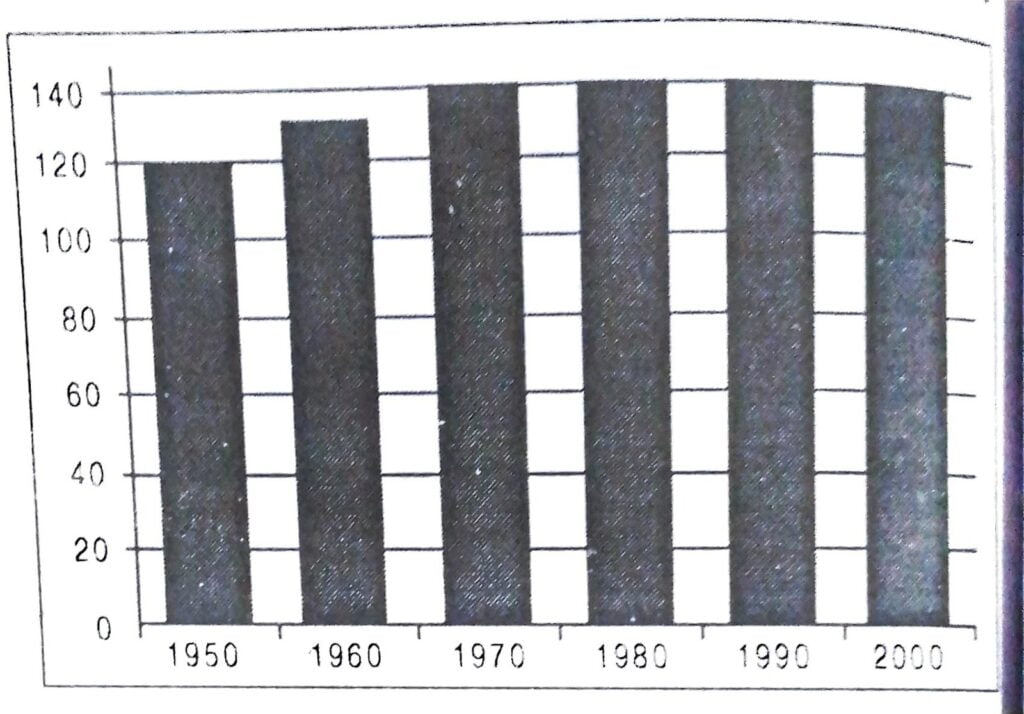
From the table and graph, we come to know that cultivated area increased upto 1970. Afterwards, there was no increase in the cultivated area.
2. Is it important to increase the area under irrigation? Why?
Ans. Yes. By increasing the area under irrigation, we can produce more to feed the growing population of India.
3. You have read about the crops grown in Palampur. Fill the following table based on information on the crops grown in your region.
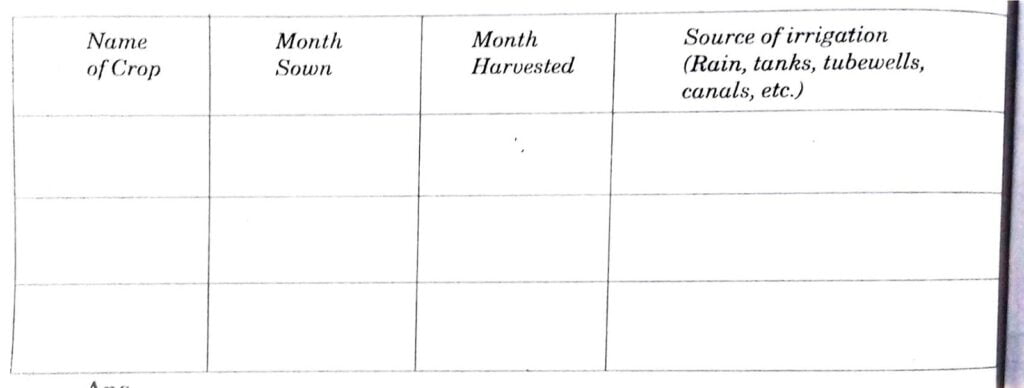
Ans.

LET’S DISCUSS
1. What is the difference between multiple cropping and modern farming methods?
Ans. Difference between multiple cropping and modern farming methods.
| Multiple Cropping | Modern Farming Methods |
| 1. Under this method more than one crop are grown on the same piece of land during the year. | 1. Under modern farming methods, much greater amount of grains is produced on a single plant or from single crop. |
| 2. Under this method cow-dung and other natural manure in used as fertilizers. | 2. Under this method, chemical fertilizers are used. |
| 3. Here traditional seeds are used. | 3. Here high yielding varieties of seeds (HYV’s) are used. |
2. The following table shows the production of wheat and pulses in India after the Green Revolution in units of million tones. Plot this on a graph. Was the Green Revolution equally successful for both the crops? Discuss.
Production of pulses and wheat
| Year | Production of Pulses | Production of Wheat |
| 1965-66 | 10 | 10 |
| 1970-71 | 12 | 24 |
| 1980-81 | 11 | 36 |
| 1990-91 | 14 | 55 |
| 2000-01 | 11 | 70 |
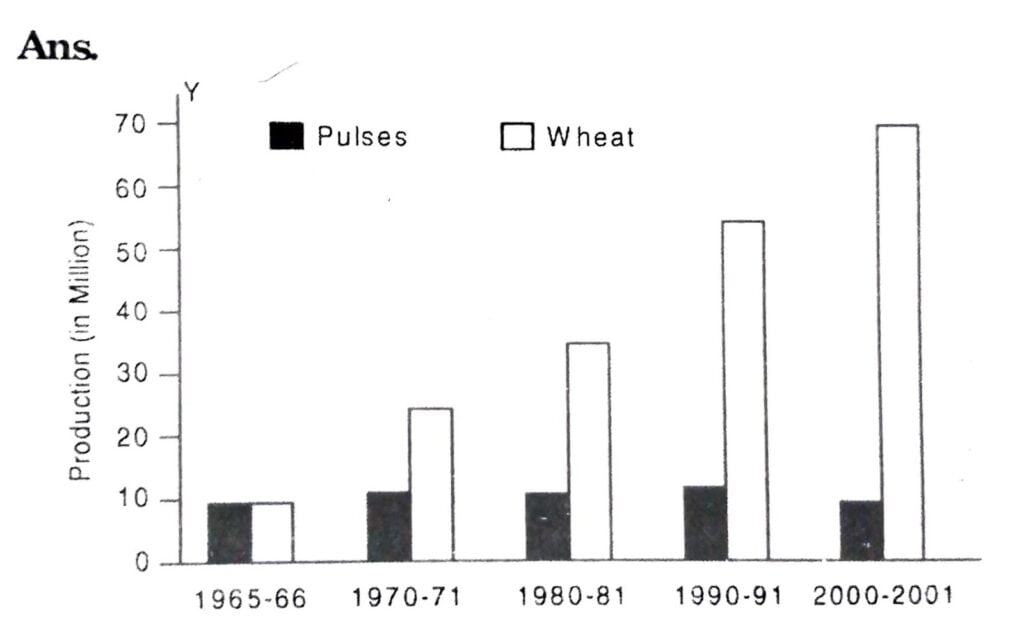
No, Green Revolution was not equally successful for both the crops. In 1965-66, the production of both pulses and wheat was 10 million tonnes. But after 35 years in 2000-01, production of pulses increased to 11 million tonnes and production of wheat increased to 70 millions tonnes.
3. What is the working capital required by the farmer using modern farming methods?
Ans. The working capital required by the farmer using modern farming methods consists of pesticides, HYV seeds, chemical fertilizers, diesel etc.
LET’S DISCUSS
1. In the picture given below, can you shade the land cultivated by the small farmers?
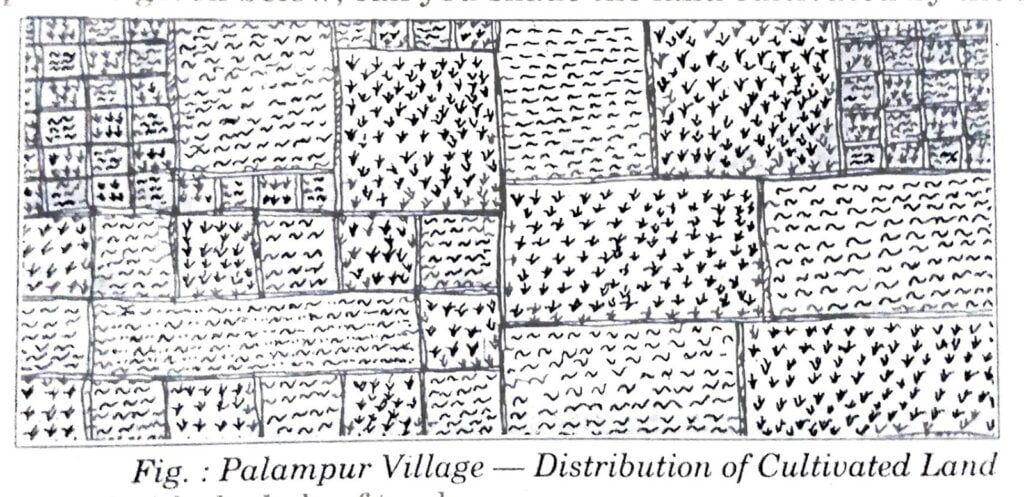
Ans. Do yourself with the help of teacher.
2. Why do so many families of farmers cultivate such small plots of land?
Ans. Due to disintegration of families existing land is divided among sons or brothers continuously and a result one have small plot of land. We know that with the increase in the size of the families of farmers, the size of land does not expand. For example Gobind was a farmer. He had three sons. He had 3 hectares of lands. After his death, his land is divided into three parts, now each son has one hectare of land. This type of division and subdivision goes on with the expansion of the size of families.
3. The distribution of farmers in India and the amount of land they cultivate is given in the following graph. Discuss in the class-room.
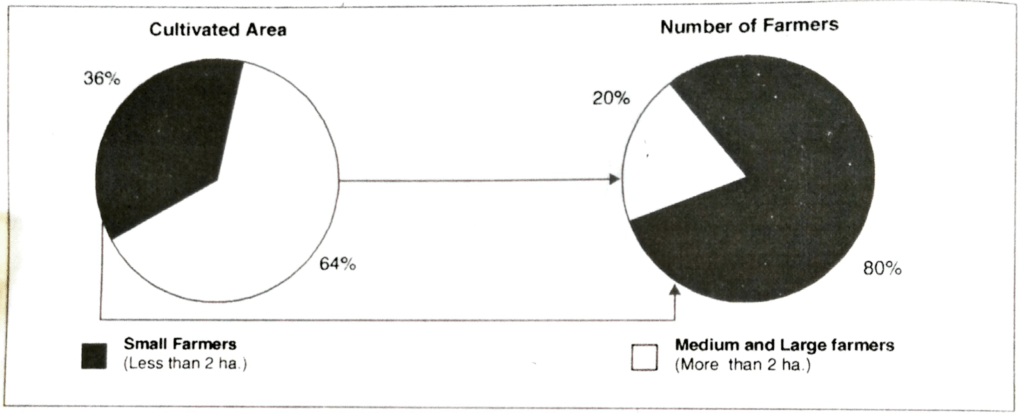
Ans. From the pie chart, we come to know that in India there are 80% farmers who have farms less than 2 hectares. These farmers cultivate only 36% of total cultivated area. On the other hand 20% of the total farmers have farms more than 2 hectares. They cultivate 64% of total cultivated area.
LET’S DISCUSS
1. Would you agree that the distribution of cultivated land is unequal in Palampur? Do you find a similar situation for India? Explain.
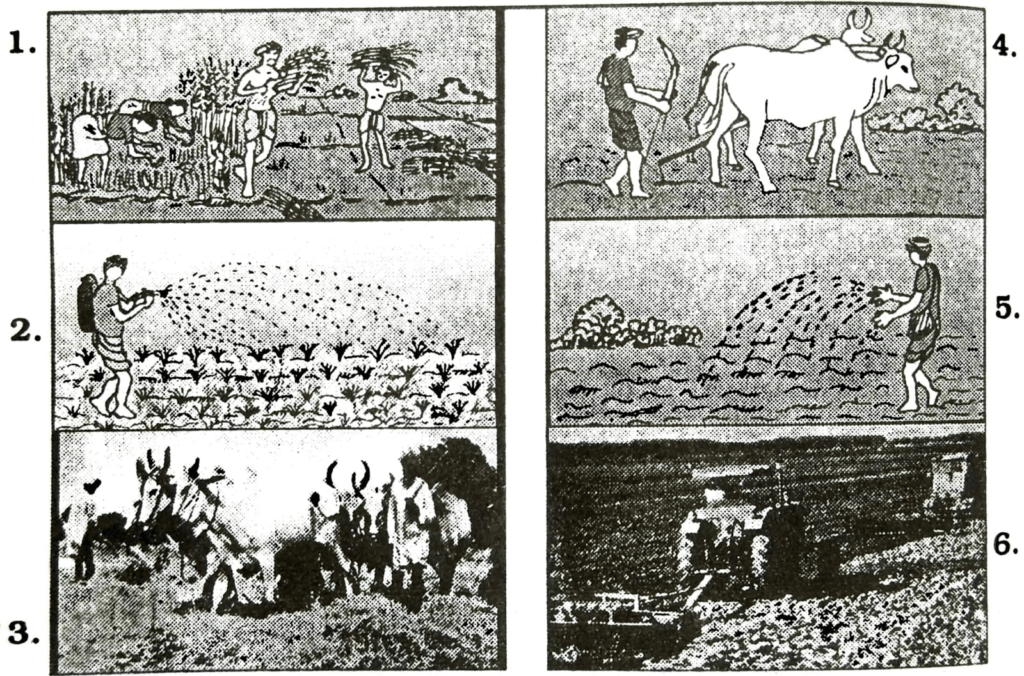
Ans. We agree that the distribution of cultivated land is unequal in Palampur. In Palampur 240 families cultivate small plots of land less than 2 hectares in size whereas 60 families cultivate more than 2 hectares of land. A few of the large farmers have land extending over 10 hectares or more.
We find the similar situation for India. Small farmers account for 80% of total farmers, but they possess only 36% of the total cultivated areas. On the other hand 20% of total farmers (medium and large farmers) have 64% of the total cultivated area.
LET’S DISCUSS
1. Identify the work being done on the field in the pictures (given above) and arrange them in a proper sequence.
1. Cutting of crops.
2. Spraying of insecticides.
3. Cultivation by traditional method.
4. Ploughing the field by bullock.
5. Sowing.
6. Cultivation by modern method.
Ans. Arranging the work being done on the field:
1. Cultivation by traditional method.
2. Cultivation by modern method.
3. Ploughing the field by bullock.
4. Sowing.
5. Spraying of insecticides.
6. Cutting of crops.
LET’S DISCUSS
1. Why are farm labourers like Dala and Ramkali poor?
Ans. Dala is landless farm labourer who works on daily wages. This means he must regularly look for work. The minimum wages for a farm labourer set by the government is Rs. 60 per day, but Dala gets only Rs. 35-40. There is heavy competition for work among the farm labourers, so people agree to work for lower wages. Dala complaints about his situation to Ramkali, who is another farm labourer.
Both Dala and Ramkali are among the poorest people in the village.
2. Gosaipur and Majauli are two villages in north Bihar. Out of a total of 850 households in the two villages, there are more than 250 men, who are employed in rural Punjab and Haryana or in Delhi, Mumbai, Surat, Hyderabad or Nagpur. Such migration is common in most villages across India. Why do people migrate? Can you describe (based on your imagination) the work that the migrants of Gosaipur and Majauli might do at the place of destination.
Ans. 1. People migrate to cities in search of job.
2. (i) Men employed in rural area might be working in household servants in the house of big zamindars.
(ii) They might be working as farm labourers.
(iii) In Delhi and other big cities they may be:
(a) Working in factories.
(b) Doing the work at hotels, shops etc.
(c) Pulling the rickshaws.
(d) Assisting the plumbers, electricians etc.
OPTIONAL EXERCISE
1. Let us take three farmers. Each has grown wheat on his field, though the production is different (see Column 2). The consumption of wheat by each farmer family is the same (Column 3). The whole of surplus of wheat this year is used as capital for next year’s production. Also suppose production is twice the capital used in production. Complete the tables.
Farmer 1

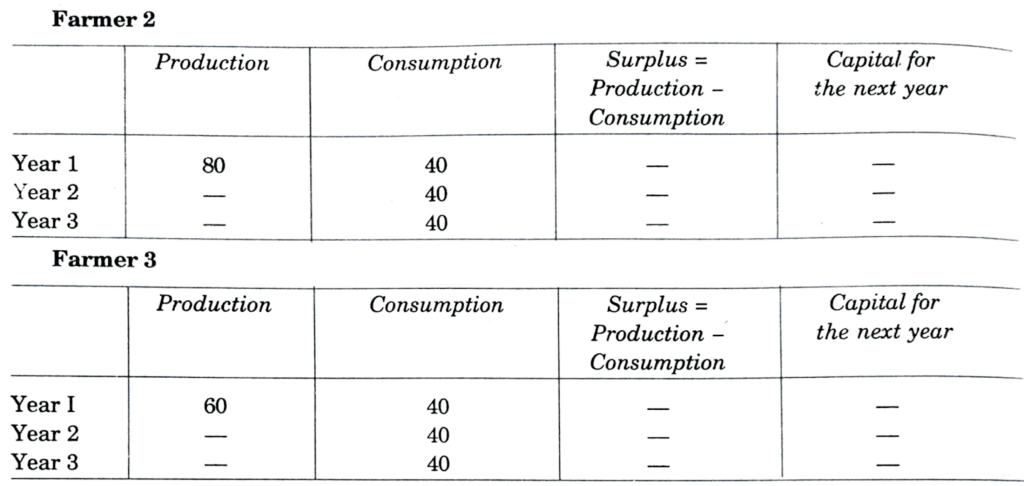
Ans. Farmer 1
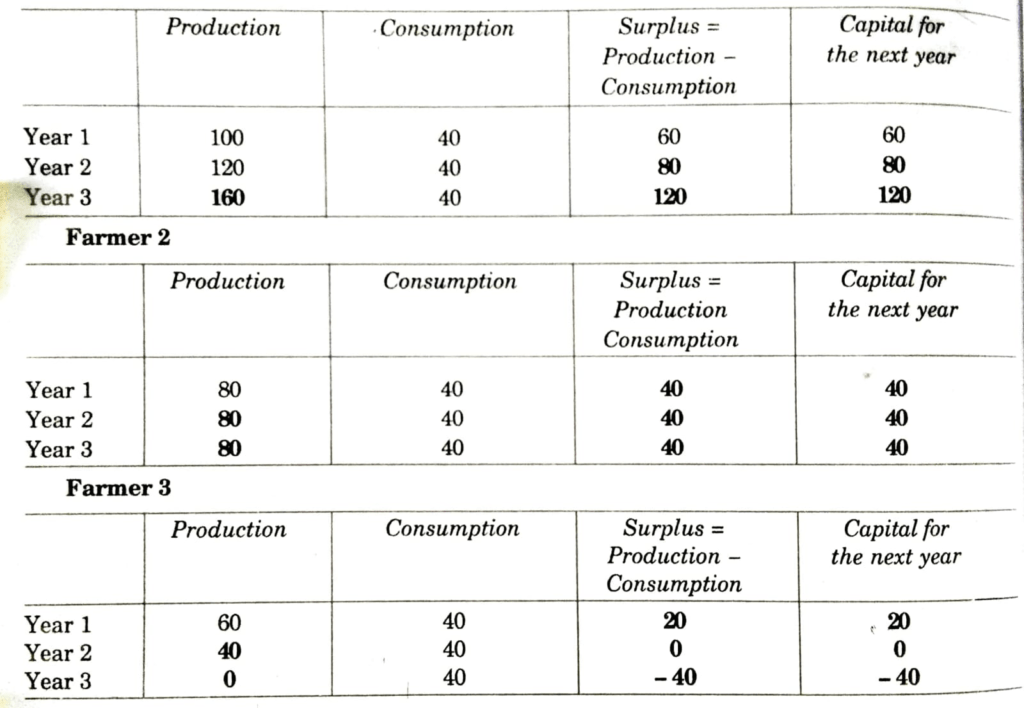
LET’S DISCUSS
1. Compare the production of wheat by the three farmers over the years.
Ans. If we compare the production of wheat by the three farmers over 3 years, we find that
(i) The production of wheat of farmer-1 is continuously increasing in first, second and 3rd year.
(ii) The production of wheat of farmer-2 is constant in three years.
(iii) The production of farmer-3 is decreasing.
2. What happens to farmer-3 in year 3? Can he continue Production? What will he have to do to continue production?
Ans. (i) Farmer-3 could not produce wheat in the 3rd year.
(ii) Yes, he can continue production.
(iii) He will have to use modern methods of farming.
LET’S DISCUSS
Read the following descriptions and answer the questions that follows:
1. Mishrilal has purchased a mechanical sugarcane crushing machine run on electricity and has set it up on his field. Sugarcane crushing was earlier done with the help of bullocks but people prefer to do it by machines these days. Mishrilal also buys sugarcane from other farmers and processes it into jaggery. The jaggery is then sold to traders at Shahpur. In the process, Mishrilal makes a small profit.
Questions:
1. What capital did Mishrilal need to set up his jaggery manufacturing unit?
Ans. Mishrilal needed mechanical sugarcane crushing machine to set up his jaggery manufacturing unit.
2. Who provides the labour in this case?
Ans. He and his family members were themselves labourers.
3. Can you guess why Mishrilal is unable to increase his profit?
Ans. Mishrilal may be unable to increase his profit as the production of sugarcane in his village is limited.
4. Could you think of any reasons when he might face a loss?
Ans. He could face loss when the price of jaggery fall.
5. Why does Mishrilal sell his jaggery to traders in Shahpur and not in his village?
Ans. Because the market for jaggery in Shahpur is big and he earn more to comparison of village.
2. Kareem has opened a computer class center in the village. In recent years, a large number of students have been attending college in Shahpur town. Kareem found that a number of students from the village are also attending computer classes in the town. There were two women in the village who had a degree in computer applications. He decided to employ them. He bought computers and set up the classes in the front room of their house over looking the market. High class students have started attending them in good numbers.
Questions:
1. In what ways is Kareem’s capital and labour different from Mishrilal’s?
Ans. Karim’s capital is computer whereas the Mishrilal’s capital is a mechanical sugarcane crushing machine. Kareem’s labour is hired whereas Mishrilal and his family members are themselves self-employed. He does not have any hired labour.
2. Why didn’t someone start a computer centre earlier? Discuss the possible reasons.
Ans. The possible reasons could be non-availability of persons having a degree in computer education, less students in college etc.
3. Kishora is a farm labourer. Like other such labourers, Kishora found it difficult to meet his family’s needs from the wages that he received. A few years back, Kishora took a loan from the bank. This was under a government programme which was giving cheap loans to poor landless households. Kishora bought a buffalo with this money. He now sells the buffalo’s milk. Further he has attached a wooden cart to his buffalo and uses it to transport various items. Once a week he goes to the river Ganga to bring back clay for the potter. Or sometimes he goes to Shahpur with a load of jaggery or other commodities. Every month he gets some work in transport. As a result, Kishora is able to earn more than what he used to do some years back.
Questions:
1. What is Kishora’s fixed capital?
Ans. Kishora’s fixed capital is a buffalo and a wooden cart.
2. What do you think would be his working capital?
Ans. His working capital would be money.
3. In how many production activities is Kishora involved?
Ans. Kishora is now involved in three production activities.
4. Would you say that Kishora has benefitted from better roads in Palampur?
Ans. Yes. Kishora has benefitted from better roads in Palampur. Due to better road; he is able to transport various items. As a result his income has increased.
EXERCICE
Q. 1. Every village in India is surveyed once in ten years during the Census and some of details are presented in the following format. Fill up the following based on information on Palampur.
(a) Location.
Ans. Location: Palampur.
(b) Total Area of the Village.
Ans. Total area of the village: 800 hectares.
(c) Land Use (In Hectares)
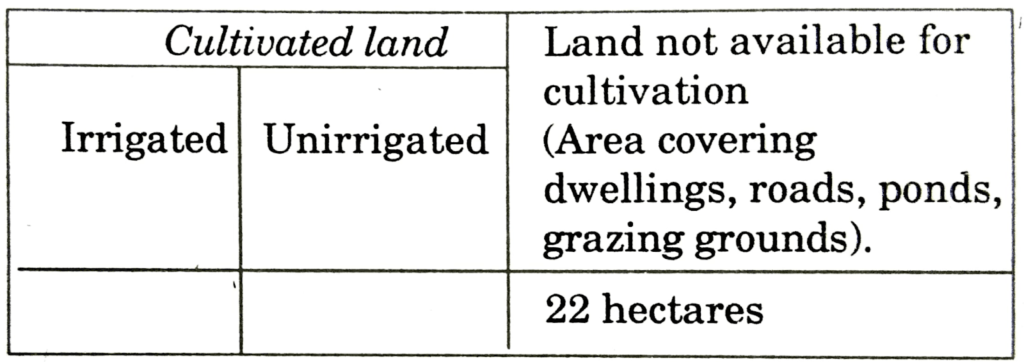
Ans. Land used (in hectares): 700
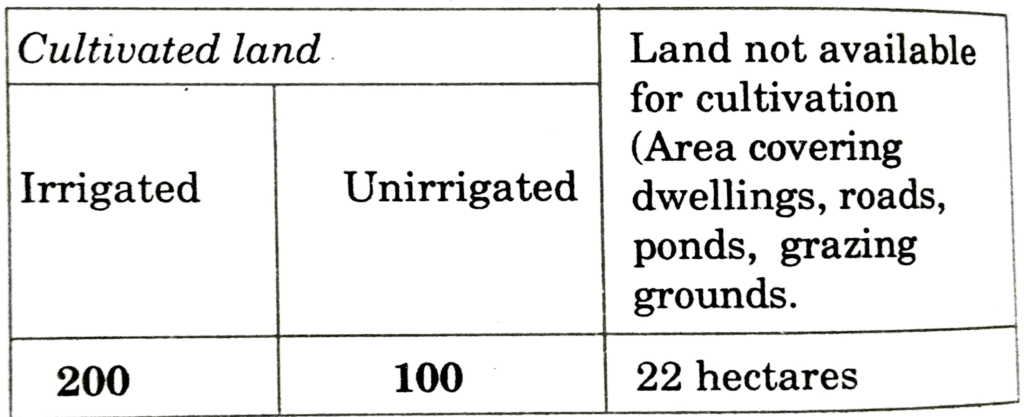
(d) FACILITIES
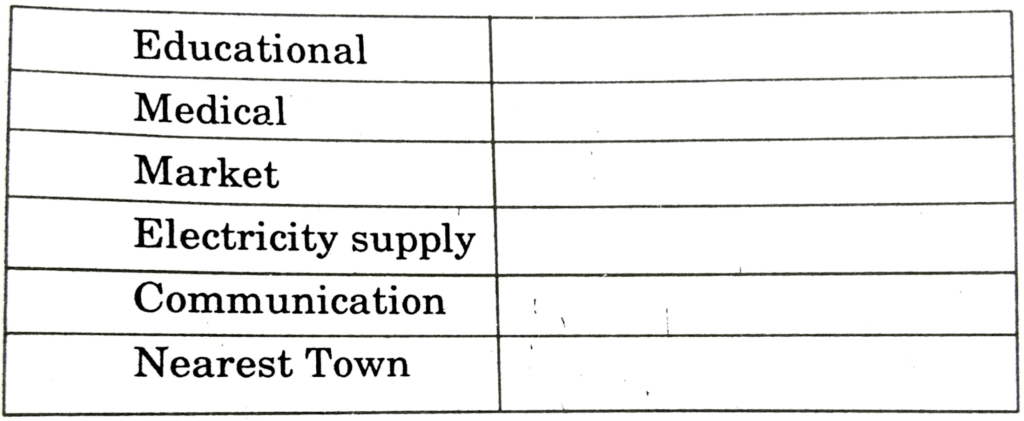
Ans. FACILITIES
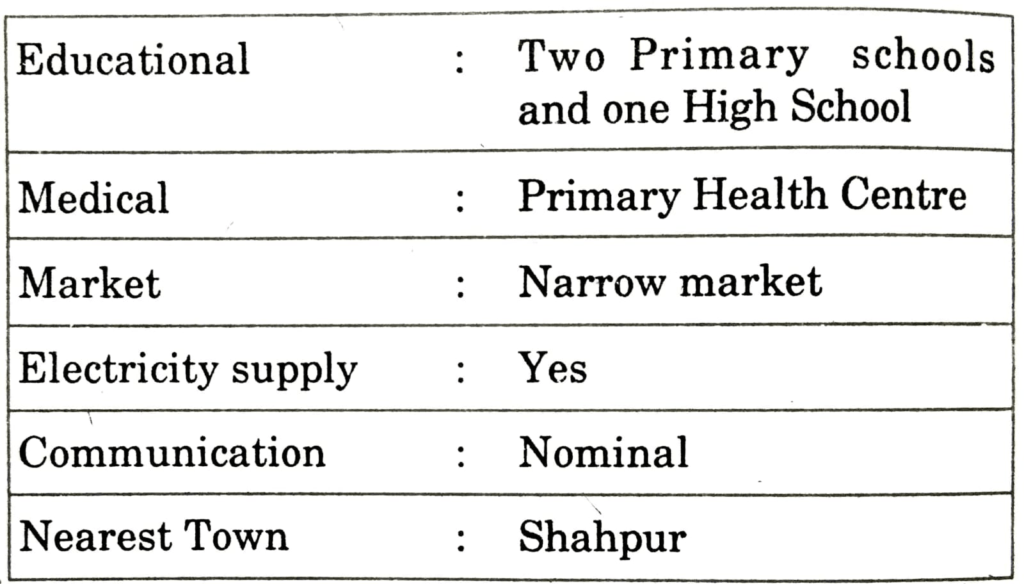
Q. 2. Modern farming methods require more inputs which are manufactured in industry. Do you agree?
Ans. Yes, we agree. For example chemical fertilizers and pesticides are required under modern farming methods. These two inputs are manufactured in industry.
Q. 3. How did the spread of electricity help farmers in Palampur?
Ans. The spread of electricity helped the farmers of Palampur in a number of ways:
(i) It helped the farmers of Palampur to irrigate their lands in a far better way. Formerly they used to irrigate their lands with the help of the Persian wheels, but it was a slow process and was not so effective. But now with the help of electricity they could irrigate much larger areas of land and that too quite quickly and effectively.
(ii) Due to better irrigation facilities as a result of the use of electricity they could grow different crops all the year round.
Q. 4. Is it important to increase the area under irrigation? Why?
Ans. Yes, it is important to increase the area under irrigation.
Reasons: Increasing the area under cultivation is important for following reasons:
1. Rainfall is uncertain and inadequate.
2. There are certain food and cash crops such as rice, wheat, sugarcane which requires adequate and regular supply of water.
3. HYV seeds need plenty of water.
Q. 5. Construct a table on the distribution of land among 450 families of Palampur.
Ans. Distribution of land among 450 families of Palampur
| No. of families | Area of land |
| 150 | Landless |
| 240 | Less than 2 hectares |
| 60 | More than 2 hectares |
Q. 6. Why are the wages for farm labourers in Palampur less than minimum wages?
Ans. Because there exists abundance labour force and the land is fixed.
Q. 7. In your region, talk to two labourers. Choose either farm labourers or labourers working at construction sites. What wages do they get? Are they paid in cash or kind? Do they get work regularly? Are they in debt?
Ans. After having talk to two labourers Working at construction sites, we have got the following information about them:
1. They get Rs. 90 per day as wages.
2. They are paid in cash.
3. No, they do not get work regularly.
4. No, they are not in debt.
Q. 8. What are the different ways of increasing production on the same piece of land? Use examples to explain.
Ans. Different ways of increasing production on the same piece of land: Following are two methods of increasing production on the same piece of land:
1. Multiple Cropping Method: Under this method more than two crops are raised on a piece of land during the year. It is the most common way of increasing production on a given piece of land. Multiple cropping is possible if there exists well-developed system of irrigation.
2. Modern Farming Methods: The other method for having higher yield is known as modern farming methods. Under modern farming methods:
(i) High yielding varieties of seeds (HYVs) are used in place of traditional seeds.
(ii) Chemical fertilizers are used in place of cow-dung and other natural manure as fertilizers.
(iii) Irrigation is done by tube-wells.
(iv) Tractors and threshers are used in farming.
(v) Pesticides are sprayed.
Q. 9. Describe the work of a farmer with 1 hectare of land.
Ans. He works as agricultural labour on the land of others.
Q. 10. How do the medium and large farmers obtain capital for farming? How is it different from the small farmers?
Ans. Medium and large farmers obtain capital from their past savings for farming. Generally their production is more than their consumption. They sell the surplus in market and have money. It is their saving. But the small farmers do not have savings. They arrange capital by taking loans from moneylenders or large farmers.
Q. 11. On what terms did Savita get a loan from Tejpal Singh? Would Savita’s condition would be different if she could get a loan from the bank at a low rate of interest?
Ans. Savita got a loan from Tejpal Singh on the following terms:
1. The interest rate on the loan would be 24% for four months.
2. She was required to work on Tejpal Singh’s field as a farm labourer during the harvest season at Rs. 35 per day.
Yes, her condition would be different if she could get loan from the bank at the lower rate.
Q. 12. Talk to some old residents in your region and write a short report on the changes in irrigation and changes in production methods during the last 30 years.
Ans. I talked two old residents in my region in connection with the irrigation and method of farming 30 years back. I found many changes in irrigation and production methods. The following report conveys the changes over the last 30 years:
1. Irrigation: 30 years back, the method of irrigation was a very tedious job. Persian wheels were used by the farmers to draw water from the wells and irrigate small fields. During the period of 30 years, the system of irrigation changed. People saw that the electric run tube-well could irrigate much larger areas of land more effectively. The first few tube-wells were installed by the government. Soon, farmers started setting up private tube-wells.
2. Production Method: Sugarcane crushing was earlier done with the help of bullock, but people prefer to do it by mechanical sugarcane crushing machine run on electricity now a days.
Q. 13. What are the non-farm production activities taking place in your region? Make a short list.
Ans. Transport, shopkeeper, small scale manufacturing of shoes, readymade garments, dairy are main non-farm production activities taking place in our region.
Q. 14. What can be done so that more non-farm production activities can be started in villages?
Ans. Steps to be taken for starting more non-farm production activities in villages: Following steps can be taken for increasing non-farm production activities in villages:
1. The villages should be made aware of different non-farm production activities.
2. They should be provided loans by the government at low rate of interest so that they may start or expand non-farm production activities.
3. Easy and cheap transport facilities should be provided in villages so that people can easily carry goods to and from the nearby markets.
SOME OTHER IMPORTANT QUESTIONS FOR EXAMINATION
MULTIPLE CHOICE QUESTIONS
Q. 1. ‘Operation Flood’ is related to:
(a) control flood.
(b) produce fish.
(c) milk production.
(d) grain production.
Ans. (c) milk production.
Q. 2. The aim of production is to:
(a) produce the goods and services that are not so important for us.
(b) produce goods and services that are required for the well to do people.
(c) produce goods and services that are essential for marginal sections of the society.
(d) produce goods and services that are essential for all of us.
Ans. (d) produce goods and services that are essential for all of us.
Q. 3. Scope of farming activity is limited in Palampur due to:
(a) fixed amount of land.
(b) lack of irrigation.
(c) lack of labour.
(d) none of the above.
Ans. (a) fixed amount of land.
Q. 4. Entrepreneur is a person who:
(a) extend loans to those who need.
(b) puts together land, labour and capital for the production.
(c) is expert in technical aspects of production.
(d) manages the labour aspect of production.
Ans. (b) puts together land, labour and capital for the production.
Q. 5. Which area in India has a low level of irrigation?
(a) Deccan plateau.
(b) Coastal regions.
(c) Riverine plains.
(d) Both (a) and (b).
Ans. (a) Deccan plateau.
Q. 6. In the question given below, there are two statements marked as Assertion (A) and Reason (R). Read the statements and chose the correct option.
Assertion (A): Farmers in Palampur are able to grow three different crops in a year.
Reason (R): Land area under cultivation is practically fixed.
Options:
(a) Both (A) and (R) are true and (R) is the correct explanation of (A) ) is not.
(b) Both (A) and (B) are true but (R) is not the correct explanation of (A).
(c) (A) is true but (R) is false.
(d) (A) is false but (R) is true.
Ans. (b) Both (A) and (B) are true but (R) is not the correct explanation of (A).
Q. 7. In the question given below, there are two statements marked as Assertion (A) and Reason (R). Read the statements and chose the correct option.
Assertion (A): Land, a natural resource, is subject to degradation.
Reason (R): It is because of the continuous use of groundwater from tubewell.
Options:
(a) Both (A) and (R) are true and (R) is the correct explanation of (A).
(b) (A) is true but (R) is not the correct explanation of (A).
(c) (A) is true but (R) is false.
(d) (A) is false but (R) is true.
Ans. (c) (A) is true but (R) is false.
Q. 8. In the question given below, there are two statements marked as Assertion (A) and Reason (R). Read the statements and chose the correct option.
Assertion (A): Non-farm activities are the main activities in the villages like Palampur, in India.
Reason (R): 75 per cent of the people who are working are dependent on farming for their livelihood.
Options:
(a) Both (A) and (R) are true and (R) is the correct explanation of (A).
(b) (A) is true but (R) is not the correct explanation of (A).
(c) (A) is true but (R) is false.
(d) (A) is false but (R) is true.
Ans. (d) (A) is false but (R) is true.
Q. 9. In the question given below, there are two statements marked as Assertion (A) and Reason (R). Read the statements and chose the correct option.
Assertion (A): Farmers in Palampur are able to grow three different crops in a year.
Reason (R): It has been possible due to the well-developed system of irrigation.
Options:
(a) Both (A) and (R) are true and (R) is the correct explanation of (A).
(b) (A) is true but (R) is not the correct explanation of (A).
(c) (A) is true but (R) is false.
(d) (A) is false but (R) is true.
Ans. (a) Both (A) and (R) are true and (R) is the correct explanation of (A).
Fill in the Blanks:
(i) Growing more than two crops on a piece of land during the year is called ___________.
Ans. multiple cropping.
(ii) In Uttar Pradesh, Punjab and Haryana, _________ methods of farming were introduced.
Ans. modern.
(iii) Land is the scarce natural factor of _________.
Ans. production.
(iv) __________ fertilizers can kill bacteria and other microorganisms in the soil. refers to the stock of skill.
Ans. Chemical.
(v) ___________ refers to the stock of skill and expertise of a nation at a point of time.
Ans. Human capital.
True and False:
(i) In villages like Palampur Tongas, Motorcycles, Bullock Carts, Bogeys, Tractors etc. are means of transport.
Ans. True.
(ii) ₹ 70 per day is the minimum wage set by the government for a farm labourer.
Ans. False.
(iii) Tools, machines, buildings etc., are physical capital.
Ans. True.
(iv) The consumption of chemical fertilizers is highest in Chhattisgarh.
Ans. False.
(v) Jowar and bajra are grown in winter season.
Ans. False.
VERY SHORT ANSWER TYPE QUESTIONS
Q. 1. What does modern cropping refer to?
Ans. Modern cropping refers to the use of high yields with the combinations of HYV seeds, irrigation, chemical fertilizers, pesticides, etc.
Q. 2. List the states of India where the modern methods of farming were introduced first.
Ans. The states where the modern methods of farming were introduced first are listed below:
(i) Uttar Pradesh.
(ii) Punjab. and
(iii) Haryana.
Q. 3. How are chemical fertilizers disadvantageous far modern farming?
Ans. Chemical fertilizers kill bacteria and microbes. They are essential for the fertility of soil. Hence, they are disadvantageous for modern farming.
Q. 4. What does HYV stand for?
Ans. HYV stands for High Yield Variety. They increase the production of crops.
Q. 5. Define capital.
Ans. Finance raised to operate a business can be defined an capital.
Q. 6. What kind of capital is money?
Ans. Money is working capital.
Q. 7. Where do most of the small farmers borrow money to arrange for capital in Palampur?
Ans. In village Palampur there are money lenders. Most of the small farmers borrow money from them. Hence, they arrange for capital.
Q. 8. Give two examples of fixed capital.
Ans. Very Simple tools such as the farmer’s plough to the sophisticated machines such as generators, turbines, computers etc. are called fixed capital.
Q. 9. What is the standard unit for measuring lands in the villages?
Ans. Hectare is the standard unit for measuring lands in the villages. Besides, Bigha and Guintha are the local units popular in the different parts of the country.
Q. 10. Which is the scarce natural factor of production?
Ans. Land is the scare natural factor of production.
Q. 11. Which term is used for production for self-consumption?
Ans. Subsistence farming is the term used for production for self-consumption.
Q. 12. State two examples of Kharif crops.
Ans. Jowar and bajra are the two examples of Kharif crops.
Q. 13. Why do the farmers of Palampur follow multiple cropping? Choose the correct answer:
(a) Because the water consumption is less in this method.
(b) Because this method consumes less chemical fertilizers.
(c) Because this method does not require fertile soils.
(d) Because this method is the most common way of increasing production.
Ans. (d) Because this method is the most common way of increasing production.
Q. 14. Write two effects of the modern farming.
Ans. Two effects of the modern farming are given below:
(i) Soil degradation.
(ii) Water pollution. and
(iii) Decrease in ground water
Q. 15. What is multiple cropping?
Ans. To grow more than one crop on a piece of land during the year is known as multiple cropping.
Q. 16. What does the term yield mean?
Ans. The term yield means the amount of crop produced on a given piece of land during a single season.
Q. 17. Write two examples of working capital.
Ans. Two examples of working capital are as given below:
(i) Row material.
(ii) Money.
Q. 18. List the important factors which increase the production of crops.
Ans. The important factors which increase the production of crops are listed below:
(i) Capital.
(ii) Land.
(iii) Labour.
(iv) Chemical fertilizers.
(v) HYV seeds.
Q. 19. What was the aim of Green Revolution?
Ans. The aim of Green Revolution was the high increase in the agricultural production due to adoption of new techniques of farming.
Q. 20. Why do the people from the rural areas migrate to the urban areas?
Ans. In the urban areas there are better opportunities of employment. So, the people from the rural areas migrate to the Urban areas.
Q. 21. Explain any three requirement for the production of goods and services.
Ans. Requirement for the production of goods and services.
(i) The land and other natural resources are the first requirement for the production of goods services.
(ii) People are the second requirement because they carry out the process of production.
(iii) Physical capital is the third requirement.
In the process of production varieties of inputs are required. For example, building, equipment, machinery tools, etc. cash raw materials, etc. are working capital. They are also required for the production of goods and services.
Q. 22. Modern farming methods require more amount of capital investment. Small farmers have to pay higher rate of interest on money borrowed because
(a) They have to borrow from large farmers or village moneylenders or the traders who supply various inputs for cultivation.
(b) The risk profile of small farmers is very high.
(c) Both (a) and (b).
(d) None of these.
Ans. (e) Both (a) and (b).
Q. 23. What is the basic constraint in raising farm production?
Ans. The basic constraint in raising farm productions is land because it is a fixed factor of production.
Q. 24. The minimum wages for a farm labourer set by government is ₹ 60 per day. In actual, farm labourers get less than fixed amount due to competition for work among the farm labourers. This results in:
(a) Migration of rural population to urban areas and rural development.
(b) Migration of rural population to urban areas and creation of urban slum areas.
(c) Migration of rural population to urban areas and rural poverty.
(d) Migration of rural population to urban areas and urban development.
Ans. (b) Migration of rural population to urban areas and creation of urban slum areas.
Q. 25. List the non-farming activities popular in Palampur.
Ans. The non-farming activities popular in Palampur are listed below:
(i) Manufacturing.
(ii) Transport.
(iii) Computer education. and
(iv) Shopkeeping.
Q. 26. Which one of the following activities is non-agricultural activities?
(i) Sugarcane Plantations.
(ii) Drive bullock cart on rent.
(iii) Farming of wheat.
Ans. (ii) To drive bullock cart on rent.
SHORT ANSWER TYPE QUESTIONS
Q. 1. Write down the disadvantages of using chemical fertilizers.
Ans. Disadvantages of using chemical fertilizers:
1. Chemical fertilizers provide minerals which dissolve in water and are immediately available to plants. But these may not be retained in the soil for long. They may escape from the soil and pollute groundwater, rivers and lakes.
2. Chemical fertilizers can also kill bacteria and other microorganisms in the soil. This means some time after their use, the soil will be less fertile.
3. Use of chemical fertilizers raises the cost of cultivation very high.
Q. 2. Which activities under modern farming methods were carried out by the farmers of Punjab, Haryana and Western Uttar Pradesh?
Ans. Following activities under modern farming methods were carried out by the farmers of Punjab, Haryana and Western Uttar Pradesh:
1. Setting up of tubewells for irrigation.
2. Making use of HYV seeds, chemical fertilizers and pesticides in farming.
3. Purchasing farm machinery like tractors, threshers etc.
Q. 3. What are the different ways of increasing production on the same piece of land? Explain them in brief.
Ans. Two methods are used for increasing production on the same piece of land. They are Multiple cropping method and Modern farming method.
Q. 4. What is physical capital? Name the items that come under physical capital.
Ans. Physical capital: It is one of the four requirements for the production of goods and services.
Items under physical capital: Items under physical capital can be classified into fixed capital and working capital.
(i) Physical Capital: Tools, machines, buildings etc. are physical capital.
(ii) Working Capital: Raw materials and money are called working capital.
Q. 5. There are four requirements for production of goods. Three of them are land, labour and human capital. Which one is the fourth? Give the classification of that requirement with examples.
Ans. The fourth requirement is physical capital.
Physical capital is of two types:
(i) Fixed capital such as tools, machines. building, a farmer’s plough, generators etc.
(ii) Working capital such as raw materials, money in hand etc.
Q. 6. In what ways are Karim’s capital and labour different from those of Mishrilal?
Ans. Difference between Karim and Mishrilal in respect of capital and labour.
| Factors of Production | Karim | Mishrilal |
| 1. Capital | Karim’s capital is both physical and human. | Mishrilal’s capital is only physical. |
| 2. Labour | His labour is unskilled and skilled. | His labour is unskilled. |
Q. 7. Differentiate between human capital and physical capital.
Ans. Difference between human capital and physical capital:
| Human Capital | Physical Capital |
| 1. Human capital refers to the stock of skill and expertise of a nation at a point of time. | 1. Physical capital refers to the stock produced means of production. |
| 2. Human capital has relatively moreeconomic value. | 2. Physical capital has relatively less economic value. |
| 3. Human capital is intangible. | 3. Physical capital istangible. |
| 4. Human capital cannot be sold in the market. Only the services of human capital are sold in the market. | 4. It can be easily sold in the market like an other commodity. |
| 5. Human capital is inseparable from its owner. | 5. Physical capital is separable from its owner. |
Q. 8. Describe the ways through which the farmers of Palampur were able to grow more from the same land.
Ans. Farmers are able to grow three different crops in a year in Palampur, It is due to well-developed system of irrigation. During the rainy season, farmers grow jowar and bajra. They cultivate potato between October and December. In the winter season, fields are sown with wheat. A part of the land area is also developed to sugarcane which is harvest once every year. The large farmers retain a part of wheat for their family’s consumption and sell the surplus is the market. They use their earnings to buy another agricultural tools also.
Q. 9. “Green Revolution is associated with loss of soil fertility.” In the light of the statement, mention five problems caused by modern farming.
Ans. 1. Green Revolution: Great increase in agricultural production due to adoption of new technique of farming is known as Green Revolution.
2. Advantages of Green Revolution: Increase in the production of wheat and rice. India became self-sufficient in food grains.
The green revolution is associated with the loss of solid fertility. The green revolution uses chemical fertilizers, pesticides, weedicides and insecticides, which reduce the natural fertility of soil. The green revolution as such no doubt has increased the production of foodgrains but at the cost of the loss of soil fertility. It has also resulted in the degradation of soil.
Q. 10. Write down the advantages and disadvantages of Green Revolution.
Ans. Advantages:
1. Increase in the production of wheat and rice.
2. India became self-sufficient in food-grains.
Disadvantages:
1. Loss of soil fertility due to increased use of chemical fertilizers.
2. Reduction of water table below the ground.
3. Pollution of groundwater, rivers and lakes.
Q. 11. Name the state of India where the consumption of chemical fertilizers is highest. What have been the consequences of the continuous use of chemical fertilizers?
Ans. The consumption of chemical fertilizers is highest in Punjab.
Consequences: The continuous used of chemical fertilizers has led to degradation of soil health. Punjab’s farmers are now forced to use more and more chemical fertilizers and other inputs to achieve the same production level. This means cost of cultivation is very high.
Q. 12. What do you know about
(i) the ads.
(ii) transport. and
(iii) electricity of alampur village?
Ans. 1. Roads: Palampur has an all weather road which connects the village to raniganj and Shahpur.
2. Transport: There are various kinds of transport in Palampur such as bullock carts, tongas, bogeys, motor-cycles, jeeps, tractors and nicks.
3. Electricity: Most of houses in Palampur have electric connection.
Q. 13. Palampur has fairly developed system of irrigation, schools and health centre. Do you agree with this statement? Give arguments in favor of your answer.
Ans. Yes, I agree with the statement. It is clear from the following facts:
1. Irrigation: The entire cultivated area of Palampur is irrigated.
2. Schools: There are two primary schools and one high school.
3. Health Centres: There is a primary health centre run by the government and one private dispensary.
Q. 14. When are wheat, potato and rice harvested?
Ans.
| Name of crop | Month harvested |
| 1. Wheat | March-April |
| 2. Potato | February-March |
| 3. Rice | November-December |
Q. 15. Write down the sources of irrigation of wheat, potato and rice. Also write when these crops are sown.
| Name | Source of Irrigation | Month sown |
| 1. Wheat | Tubewells, tanks | November- December. |
| 2. Potato | Rain, tanks | October- December |
| 3. Rice | Rain, Tubewells | June-July |
Q. 16. Name two agricultural seasons. Name the crops of these agricultural seasons.
Ans. Agricultural seasons: There are two agricultural seasons—
1. Rabi season. and
2. Kharif season.
Crops of Rabi season: Wheat and grain.
Crops of Kharif season: Jowar and Bajra.
Q. 17. Write a short note on Dairy—the other common non-farm production activity carried in Palampur village.
Ans. Many non-farm production activities are carried in Palampur village. One of them is Dairy. Dairy is a common activity in many families of Palampur. People feed their buffaloes on various kinds of grass and the jowar and bajra that grows during the rainy season. The milk is sold in Raiganj, the nearby large village. Two traders from Shahpur town have setup collection-sum-chilling centers at Raiganj from where the milk is transported to far away towns and cities.
Q. 18. Explain any five efforts which can be made to increase non-farming production activities in villages.
Ans. Transport, shopkeeper, small scale manufacturing of shoes, readymade garments, dairy are main non-farm production activities taking place in village.
Steps to be taken for starting more non-farm production activities in villages:
Following steps can be taken for increasing non-farm production activities in villages:
1. The villages should be made aware of different non-farm production activities.
2. They should be provided loans by the government at low rate of interest so that they may start or expand non-farm production activities.
3. Easy and cheap transport facilities should be provided in villages so that people can easily carry goods to and from the nearby markets.
Q.19. What are the various farming and non-farm activities in village Palampur?
Ans. (a) Farming activities: Sowing, ploughing, harvesting etc.
(b) Non-Farming activities: Dairy, small scale manufacturing, shop-keeping and transport are the main non-farm activities in Palampur.
Q. 20. Is Palampur a developed village? Explain by presenting four points.
Ans, Yes, Palampur is a developed village. It is clear from the fallowing facts:
1. Palampur is well-connected with neighboring village and towns. An All weather road connects the village to Raiganj. Many kinds of transport are available on this road.
2. Palampur has two primary schools and one high school.
3. Most of the houses in Palampur have electric connections.
4. Electricity powers all the tube-wells in the fields and is used in various types of small business.
Q. 21. What problem do farm labourers face is terms of employment? Explain any three problems.
Ans. Problems faced by farm-labourers:
1. They work on daily wages. They have to look for work regularly.
2. They work for lower wages.
3. They do not have a right over the crops grown on the land.
4. They face huge competition for work among themselves.
Q. 22. Write any three factors which have enabled the farmers to increase the production of their land.
Ans. Three factors enabling the farmers to increase the production of land:
1. Well-developed system of irrigation.
2. Growing more than two crops on a piece of land (i.e. Multiple cropping)
3. Cultivating all land.
Q. 23. What is Green Revolution? Which crop benefitted the most due to Green Revolution?
Ans. Green Revolution: Green Revolution means large increase in production of foodgrains due to use of high yielding varieties (HYV) of seeds, chemical fertilizers and pesticides.
Wheat crop benefitted the most due to Green Revolution.
Q. 24. What are the various ways through which farmers can get loans?
Ans, Small farmers can get loans from large farmers, the village moneylenders or the traders who supply various inputs for cultivation. In contrast to the small farmers, the medium and large farmers need not to get loan as they have their own savings from farming.
Q. 25. What is difference between Rahi crops and Kharif crops? When are they sown and harvested?
Ans. Jowar and bajra are Kharif crops whereas wheat is a Rabi crop.
Jowar and bajra are grown in rainy season, whereas wheat is in winter season.
Q. 26. Give similarities between physical capital and human capital.
Ans. Similarities between physical capital and human capital.
1. Both are required for the production of goods and services. In other words both are factors of production.
2. Both forms of capital depreciate with time.
3. Benefits flow from both type of capital.
4. The formation of both the capitals are outcomes of conscious investment decisions.
Q. 27. How can you say that there is multiple cropping in Palampur village?
Ans. Multiple cropping in Palampur Villages: Farmers are able to grow three different crops in a year in Palampur. It is due to well-developed system of irrigation. During the rainy season, farmers grow jowar and bajra. They cultivate potato between October and December. In the winter season, fields are sown with wheat. A part of the land area is also developed to sugarcane which is harvest once every year.
Q. 28. How do the large farmers use their earnings from the sale of their surplus?
Ans. Using of earnings from the sale of in their surplus: The large farmers retain a part of wheat for their family’s consumption and sell the surplus in the market. They use their earnings from the sale of surplus in the following ways:
1. They deposit most of the money in the banks.
2. They lend money to farmers.
3. They use the savings to arrange for the working capital for farming in next session.
4. They may use their earnings to buy another tractor.
Q. 29. What is modern farming?
Ans. Modern farming:
1. Modern farming is that type of farming which has following features:
1. In this type of farming tube-wells are used for irrigation.
2. HYV seeds, chemical fertilizers and pesticides are used in modern farming.
3. Farm machinery like tractors, threshers etc. are used for fast ploughing and harvesting.
Q. 30. Who provides labour for farming? How are farm labourers paid?
Ans. Labour is one of the factors of production. It is required for production. Small farmers along with their families cultivate their own fields. Thus they provide the labour required for farming themselves. On the other hand, medium and large farmers hire labourers to work on their fields.
Q. 31. You are living in a village where majority of the people are engaged in agricultural activity. Give three suggestions to increase non-agricultural activities in the village.
Ans. (i) The villagers should be made aware of different non-agricultural activities.
(ii) They should be provided loans by the government at low rate of interest to start and expand the non- agricultural activities.
(iii) More and more villagers should be connected to towns and cities through good roads, transport and means of communication.
Q. 32. Differentiate between fixed capital and working capital.
Or
Give a comparative study of fixed capital and working capital. Give any two points.
Ans. Difference between fixed capital and working capital.
| Fixed Capital | Working Capital |
| 1. Fixed capital can be used in production over many years. In other words it is depreciated. | (a) Working capital are used up in production. |
| 2. Tools, machines, buildings are examples of fixed capital. | (b) Raw materials and money in hand are examples of working capital. |
LONG ANSWER TYPE QUESTIONS
Q. 1. What is the difference between multiple cropping and modern farming method?
Ans. Difference between multiple cropping and modern farming:
| Multiple Cropping | Modern Farming |
| 1. Under this method, the same land is used for different crops. | 1. Under this method, land is used for single crop using better variety of seeds and fertilizers. |
| 2. Multiple cropping has traditional cultivation method with relatively low yield. | 2. Modern farming has modern equipment, chemical fertilizers etc., with higher yield. |
| 3. Traditional seeds are used which require less irrigation. | 3. Higher yielding variety of seeds are used to produce greater amount of grain from single plant. |
| 4. Pump set, electricity, pesticides etc., are not required under this method. | 4. Pump set, electricity and pesticides are required under this method. |
Q. 2. Why do so many families of farmers Cultivate such small plots of land in village Palampur?
Ans. The following are the reasons for so many families of farmers cultivating small plots land:
(i) In Palampur about 1/3rd of the 450 families are landless and most of them are Dalits.
(ii) 240 families cultivate small plot of land which is less than 2 hectares in size.
(iii) Poor farmers have scattered land and low productivity.
(iv) Rural poverty amongst the farmers is the main reason for inequality amongst the land owing farmers.
Q. 3. What do you understand by physical capital? What are the different types of capital under it? Clarify with examples.
Ans. (i) Physical capital consists of the variety of inputs required at any stage during production.
(ii) Physical capital comprises tools, machines, buildings, turbines, generators, computers, etc. These are called as fixed capital.
(iii) It also consists of raw materials and money in hand. These are called working capital.
(iv) We also need knowledge and enterprise to be able to put together land, labour and physical capital. It is called human capital.
(v) Every production is organized by having combined land, labour, physical capital. They are known as factors of production.
Q. 4. The farm labourers in Palampur usually earn less than the minimum wage. Why?
Ans. The use of modern agricultural implements like tractors, threshers and harvesters by the large and medium farmers has reduced the amount of the agricultural labour required. So there is competition for work among the agricultural labourers in the village. Knowing that the supply is much more than the demand, the labourers themselves agree to work for wages that are lower than minimum wages. The farmers exploit this condition of excess labour supply and force labourers to work for low wages.
HOTS QUESTION
Q. 1. Would you agree that the distribution of cultivated land is unequal in Palampur? Do you think such situation is everywhere in the country.
Ans. Yes, we would agree that the distribution of cultivated land is unequal in Palampur. This is because, 1/3rd of the 450 families are landless ‘Dalits’ and 240 families have less than 2 hectares of land.
Yes, the similar situation is existing in India where a large number of farmers either landless or very less area of land holding. The main reason for unequal land distribution comes due to gap between rich and poor farmers. Rich farmers have large area of land holding which gives better yield and they can sell their crops at good profit in the market. On the other hand, poor farmers have low yield and less bargaining power in the market.
Q. 2. How is the use of chemical fertilizers harmful for the soil? Describe.
Ans. No doubt, the use of chemical fertilizers increases the production of foodgrains in the same year but it reduces the natural fertility of the soil. Next year, more chemical fertilizers are required to retain the production, which further reduces the fertility of the soil. Chemical fertilizers also increase the cost of production, because it has to be used with better irrigation facilities, pesticides and insecticides. Excessive use of tubewells reduces the natural water level of the earth, which is very difficult to recover.
Q. 3. How did the green revolution led to the loss of soil fertility? Explain.
Ans. The green revolution is associated with the loss of solid fertility. The green revolution uses chemical fertilizers, pesticides, weedicides and insecticides, which reduce the natural fertility of soil. The green revolution as such no doubt has increased the production of foodgrains but at the cost of the loss of soil fertility. It has also resulted in the degradation of soil.
Q. 4. How would Savita have benefited if she had got a loan from a bank? Explain.
Ans. If Savita could get a loan from a bank for buying seeds, fertilizers and pesticides, and other necessary expenses, then she would have definitely benefited. She would have got the loan at a reasonable rate of interest. Also, she would have been able to focus her entire attention on her farm at a time when it is most needed, i.e., at harvest time, instead of working for Tejpal Singh then. She would also have been able to devote more time to the needs of her family members, especially her three children.
On borrowing money from Tejpal Singh, she had to pay interest at a rate of 24%, besides working for him at a low wage for four months.
PASSAGE BASED QUESTIONS
1. Read the given passage and answer the questions that follow:
Mishrital has purchased a mechanical sugarcane crushing machine run on electricity and has set it up on his field. Sugarcane crushing was earlier done with the help of bullocks, but people prefer to do it by machines these days. Mishrilal also buys sugarcane from other farmers and processes it into jaggery. The jaggery is then sold to traders at Shahpur. In the process, Mishrilal makes a small profit.
(i) What capital did Mishrilal need to set up his jaggery manufacturing unit?
(a) Fixed capital in the form of farmer’s plough.
(b) Working capital in the form of sugarcane.
(c) Fixed capital in the form of machines to set up his jaggery manufacturing unit.
(d) Human capital in the form of labour.
Ans. (c) Fixed capital in the form of machines to set up his jaggery manufacturing unit.
(ii) Who provides labour in this case?
(a) Landless labourers.
(b) Highly educated workers.
(c) Bullocks.
(d) Family labour.
Ans. (d) Family labour.
(iii) In which of the following situations do the producers like Mishrilal are unable to increase their profits?
(a) The cost of production is very high.
(b) Their farm holdings are less than 2 hectares where crop production is less.
(c) The demand is very less.
(d) The markets are very far from the villages.
Ans. (b) Their farm holdings are less than 2 hectares where crop production is less.
(iv) The demand and price for jaggery in villages may be less because:
(a) people may not like jaggery.
(b) it may not be of good quality.
(c) sugarcane production is very less.
(d) many other producers in the village are also engaged in the same business.
Ans. (d) many other producers in the village are also engaged in the same business.
2. Read the given passage and answer the questions that follow:
Kishora is a farm labourer. Like other such labourers, Kishora found it difficult to meet his family’s needs from the wages that he received. A few years back Kishora took a loan from the bank. This was under a government programme which was giving cheap loans to poor landless households. Kishora bought a buffalo with this money. He now sells the buffalo’s milk. Further, he has attached a wooden cart to his buffalo and uses it to transport various items. Once a week, he goes to the river Ganga to bring back clay for the potter. Or sometimes he goes to Shahpur with a load of jaggery or other commodities. Every month he gets some work in transport. As a result, Kishora is able to earn more than what he used to do some years back.
(i) What is the fixed capital of farm labourers like Kishora?
(a) Loan from the bank.
(b) Electricity.
(c) Buffalo and wooden cart.
(d) Knowledge and enterprise.
Ans. (c) Buffalo and wooden cart.
(ii) In how many other activities is Kishora involved?
(a) Teaching and repairing computer.
(b) Sowing and harvesting in the fields of land owning farmers.
(c) Selling jaggery and working in brick making unit.
(d) Selling milk, transporting clay to potters on bullock cart and transporting commodities to cities.
Ans. (d) Selling milk, transporting clay to potters on bullock cart and transporting commodities to cities.
(iii) What role do markets play in the expansion of non-farm activities?
(a) Goods and services produced are sold in the markets.
(b) Raw materials are sold in the markets.
(c) Provides labourers for production.
(d) Provides expertise in production of goods and services.
Ans. (a) Goods and services produced are sold in the markets.
(iv) A few years back Kishora took a loan from the bank. Why did Kishora not take loan from village moneylender?
(a) He knows the bank manager.
(b) He had earlier taken loan from the bank.
(c) Loan from bank is much cheaper than the loan from village moneylender.
(d) He required less money as loan.
Ans. (c) Loan from bank is much cheaper than the loan from village moneylender.
3. Read the given passage and answer the questions that follow:
The aim of production is to produce the goods and services that we want. There are four requirements for production of goods and services. The first requirement is land, and other natural resources such as water, forests, and minerals. The second requirement is labour, i.e. people who will do the work. Some production activities require highly educated workers to perform the necessary tasks. Other activities require workers who can do manual work. Each worker is providing the labour necessary for production. The third requirement is physical capital, i.e. the variety of inputs required at every stage during production.
(i) What is unique about labour as a factor of production?
(a) It is a highly skilled factor of production.
(b) It is a very expensive factor of production.
(c) It can be used at any point of time.
(d) It is the most abundant factor of production.
Ans. (d) It is the most abundant factor of production.
(ii) What does human capital denote?
(a) Workers that can do manual works.
(b) Knowledge and enterprise to be able to put together land, labour and physical capital and produce an output.
(c) Workers that use machines to do work.
(d) Workers that work in non-farm activities.
Ans. (b) Knowledge and enterprise to be able to put together land, labour and physical capital and produce an output.
(iii) Tools, machines and buildings are termed as fixed capital. Why?
(a) These are highly expensive.
(b) These are readily available.
(c) These can be used in production over many years.
(d) These are operated by the highly efficient workers.
Ans. (c) These can be used in production over many years.
(iv) Production requires a variety of raw materials. These are called:
(a) working capital.
(b) fixed capital.
(c) factors of production.
(d) human capital.
Ans. (a) working capital.

Hi! my Name is Parimal Roy. I have completed my Bachelor’s degree in Philosophy (B.A.) from Silapathar General College. Currently, I am working as an HR Manager at Dev Library. It is a website that provides study materials for students from Class 3 to 12, including SCERT and NCERT notes. It also offers resources for BA, B.Com, B.Sc, and Computer Science, along with postgraduate notes. Besides study materials, the website has novels, eBooks, health and finance articles, biographies, quotes, and more.



